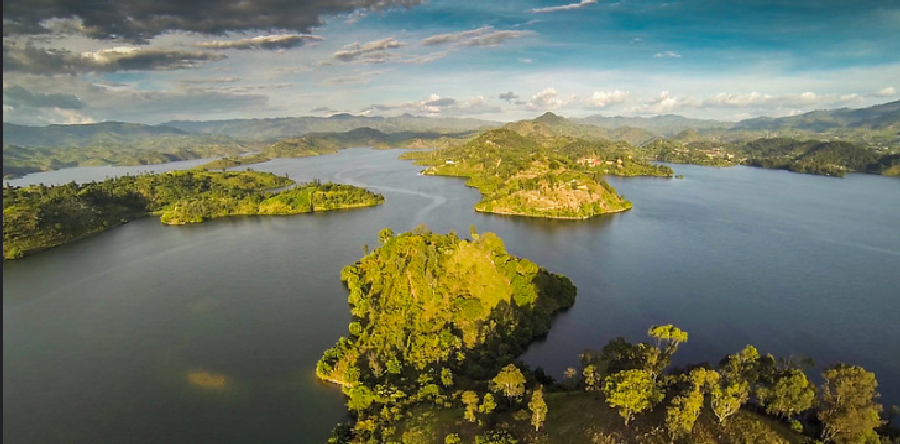Lake Kivu methane: what you need to know about this submerged energy source
The majestic landscapes of Lake Kivu, on the border between Rwanda and the DRC, would almost make you forget that the tranquility of this region of the globe is only apparent: buried in the depths of the lake is a high concentration of dissolved methane, a deadly and unpredictable gas that the Rwandan authorities are now seeking to transform into energy. Detailed review of the main points to remember.
Straddling the Democratic Republic of Congo and Rwanda, at an altitude of 1,460 m above sea level, Lake Kivu is one of Africa’s ten Great Lakes, alongside the main ones, Victoria and Tanganyika. However, its particularity lies elsewhere: with those of Nyos and Monoun in Cameroon, Kivu is one of the few lakes in the world considered to be meromictic, i.e. containing very high concentrations of gases (carbon dioxide and methane in particular), produced by the volcanic activity of the region and the decomposition of organic matter. As a result, the 2,700 km2 of this body of water - nearly 500 metres deep in places - is estimated to contain about 60 billion cubic metres of dissolved methane and about 300 billion cubic metres of carbon dioxide, which have accumulated over time.
A potential bomb….
Such a gas concentration is nevertheless problematic, as it could potentially serve as a detonator for a limenic eruption, characterized by the sudden degassing of the lake, which then releases the layers of gas accumulated over many years. In such circumstances, the human consequences can be terrible. In 1986, the gas released by Lake Nyos in Cameroon killed more than 1,700 people in a 25-kilometre radius by asphyxiation. Two years earlier, still in Cameroon, a similar phenomenon occurred on the shores of Lake Monoun, resulting in 37 deaths. However, Kivu contains… a thousand times more gas than Nyos, while being located in a very densely populated region, where more than two million people live. And as the gas concentration increases over the years, the possibility of a limenic eruption increases mechanically. Quoted by the weekly Jeune Afrique, Martin Schmid, a researcher at the Swiss Research Institute for Water and Aquatic Environments (Eawag), says nothing else when he explains that » (…) if gases are allowed to accumulate for a long time, at some point a catastrophic gas eruption can be expected ». And as if that were not enough, the proximity of the Nyiragongo volcano, one of the most active in Africa, further reinforces the plausibility of such a scenario, as a volcanic eruption could disrupt the stratification of the lake and, consequently, cause the gas to rise.
A definite energy potential
Nevertheless, this threatening concentration of methane is also, paradoxically, an opportunity. The technical developments of recent years have made it possible to commercially exploit Lake Kivu gas. According to some estimates, it could produce up to 700 megawatts of electricity, almost four times what Rwanda currently has (about 250 megawatts). This is of interest to some private operators: the country of the Thousand Hills already has two companies - the Americans Symbion Power and ContourGlobal - that extract gas from Lake Kivu to supply power plants. The first initiative, launched in 2009 off the Rwandan city of Rubavu, is a pilot project called Kibuye Power 1 with a production capacity of 3.6 megawatts. « In concrete terms, the floating platform, located three kilometres from the shore, pumps gas to the depths and then sends it down a pipeline to the mainland, where three generators produce electricity, » explains Éric Nsabimana, the facility’s operational manager, who also says « extracting methane helps stabilize the lake.

In short, gas exploitation can kill two birds with one stone: it provides electricity while reducing the risk of unintentional degassing. The second project, KivuWatt, launched in 2016, is of a completely different scale, since it currently generates 26 megawatts for the local network. A capacity that should eventually reach 100 megawatts, distributed throughout the country. A real windfall for Rwanda, which aims to achieve 100% access to electricity for its population by 2024, compared to 51% today, according to the Rwandan Ministry of Infrastructure.
Diagram of the methane gas extraction mechanism
A profitability to be demonstrated
The only drawback is that the profitability of the projects remains uncertain, as extraction is currently only carried out on a small scale. When contacted, a source working in the finance department of one of the two companies mentioned above confirms anonymously that « for the time being the company is not making any money on the methane gas unit ». A situation that, according to our interlocutor, « should not last », the time « to improve extraction processes and increase production rates ». One thing is certain: the challenge of exploiting methane gas in the Kivu region continues to attract investors. In February, the Rwandan authorities validated the signing of the agreement.
